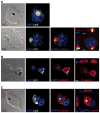A localized Wnt signal orients asymmetric stem cell division in vitro
- PMID: 23520113
- PMCID: PMC3966430
- DOI: 10.1126/science.1231077
A localized Wnt signal orients asymmetric stem cell division in vitro
Erratum in
- Science. 2013 May 24;340(6135):924
Abstract
Developmental signals such as Wnts are often presented to cells in an oriented manner. To examine the consequences of local Wnt signaling, we immobilized Wnt proteins on beads and introduced them to embryonic stem cells in culture. At the single-cell level, the Wnt-bead induced asymmetric distribution of Wnt-β-catenin signaling components, oriented the plane of mitotic division, and directed asymmetric inheritance of centrosomes. Before cytokinesis was completed, the Wnt-proximal daughter cell expressed high levels of nuclear β-catenin and pluripotency genes, whereas the distal daughter cell acquired hallmarks of differentiation. We suggest that a spatially restricted Wnt signal induces an oriented cell division that generates distinct cell fates at predictable positions relative to the Wnt source.
Figures




Comment in
-
Cell biology. Making a point with Wnt signals.Science. 2013 Mar 22;339(6126):1388-9. doi: 10.1126/science.1236641. Science. 2013. PMID: 23520097 No abstract available.
-
Cell division: different daughters.Nat Rev Mol Cell Biol. 2013 May;14(5):265. doi: 10.1038/nrm3563. Epub 2013 Apr 5. Nat Rev Mol Cell Biol. 2013. PMID: 23558926 No abstract available.
References
Publication types
MeSH terms
Substances
Grants and funding
LinkOut - more resources
Full Text Sources
Other Literature Sources

